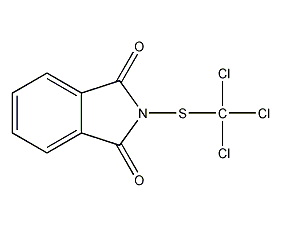
Structural formula
| Business number | 03NW |
|---|---|
| Molecular formula | C9H4Cl3NO2S |
| Molecular weight | 296.66 |
| label |
Fardan, Felton, Farton, Benkepton, Faltan,Ftalan,Phaltane,Spolacid,Diutrid, fungicides, chemical protectant |
Numbering system
CAS number:133-07-3
MDL number:MFCD00047303
EINECS number:205-088-6
RTECS number:TI5685000
BRN number:193373
PubChem number:24869029
Physical property data
1. Properties: white crystal.
2. Density (g/mL, 20℃): Uncertain
3. Relative vapor density (g/mL, air=1): Uncertain
4. Melting point (ºC): 177
5. Boiling point (ºC): Uncertain
6. Refractive index: Uncertain
7. Point (ºC): Uncertain
8. Specific rotation (ºC): Uncertain
9. Autoignition point or ignition temperature (ºC) is uncertain
10. Vapor pressure (kPa, 25ºC): 1.33×10-2
11. Saturated vapor pressure (kPa, 60ºC): Uncertain
12. Heat of combustion (KJ/mol): Uncertain
13. Critical temperature (ºC): Uncertain
14. Critical pressure (KPa): Uncertain
15. Log value of oil-water (octanol/water) partition coefficient: Uncertain
16. Explosion upper limit (%, V/V): Uncertain
17 The lower limit of the explosion (%, v/v): Uncertain
18. Solubability: slightly soluble in organic solvents; insoluble water (only 1 mg/L).
Toxicological data
Acute oral LD50 in rats is 10000mg/kg, acute transdermal administration in rabbitsLD50>22600mg/kg. Carp D500.21mg/L(48h).
Ecological data
None yet
Molecular structure data
5. Molecular property data:
1. Molar refractive index: 65.23
2. Molar volume (cm3/mol): 170.0
3. Isotonic specific volume (90.2K): 494.6
4. Surface tension (3.0 dyne/cm): 71.6
5. Polarizability (0.5 10 -24cm3): 25.85
Compute chemical data
1. Reference value for hydrophobic parameter calculation (XlogP): None
2. Number of hydrogen bond donors: 0
3. Number of hydrogen bond acceptors: 3
4. Number of rotatable chemical bonds: 1
5. Number of tautomers: none
6. Topological molecule polar surface area 62.7
7. Number of heavy atoms: 16
8. Surface charge: 0
9. Complexity: 307
10. Number of isotope atoms: 0
11. Determine the number of atomic stereocenters: 0
12. Uncertain number of atomic stereocenters: 0
13. Determine the number of chemical bond stereocenters: 0
14. Number of uncertain chemical bond stereocenters: 0
15. Number of covalent bond units: 1
Properties and stability
The pure product is white crystal. m.p.177℃, vapor pressure 1.33×10-3Pa (20℃). Slightly soluble in organic solvents; insoluble in water (only 1mg/L). It is relatively stable under dry conditions, hydrolyzes slowly when exposed to water at room temperature, and decomposes rapidly when exposed to high temperatures or alkaline substances.
It has an irritating effect on human membranes. Its dust or mist droplets come into contact with the eyes, skin, or are inhaled. All can cause local irritation. Animal experiments have found teratogenic and mutagenic effects.
Storage method
None yet
Synthesis method
1. Preparation of trichlorosulfur chloride: Mix the prepared 2% hydrochloric acid and measured carbon disulfide, stir and pass chlorine, control the flow of chlorine gas, and adjust the reaction temperature Maintain the temperature at around 26°C and control the normal absorption and processing of the reaction exhaust gas, which generally takes about 30 hours. Finally, it is left to stand to separate out trichlorosulfide methane, which is then washed with water and used for synthesizing sterilization pills.
2.Phthalimide is prepared by co-heating phthalic anhydride and ammonium bicarbonate. During production, mix phthalic anhydride and ammonium bicarbonate at a ratio of 3:1 (mass ratio), then put them into a hot melt tank, heat them with direct fire, and react at 300°C for 10 to 12 hours. Since this operation is difficult to control, the reaction is also slow. Complete, energy-consuming, long reaction cycle, and environmental pollution. Because phthalic anhydride can be added to ammonia water to dissolve it to form a diammonium salt, and the water can be evaporated. Heating to a higher temperature further dehydrates to generate imine compounds.
3.Synthesis of Felicide. Add 4.5% alkali solution into the condensation reaction pot and cool it to -4℃. After adding an excess of phthalimide solution under vigorous stirring, a certain amount of trichlorosulfur methane is evenly added dropwise, the temperature is controlled at about -2°C, the reaction endpoint pH=8, and finally the condensation material is separated by centrifugation. After post-processing such as water washing and air drying, sterilizing pills are prepared.
Purpose
1. Fossilicide is an organic sulfur fungicide, mainly used to prevent and treat various diseases of food crops, vegetables, fruit trees, etc., and has a stimulating effect on plant growth. For example, it can prevent and control rice blast, rice sheath blight, wheat rust, scab, rape downy mildew, peanut leaf spot, potato late blight, tomato early blight, tobacco anthracnose, apple anthracnose, etc.
2.Trichloromethane-based protective fungicide. It is mainly sprayed to prevent and control various diseases of grain and oil crops, vegetables, fruit trees, etc., and has the effect of stimulating the growth of plants. To prevent and control rice blast, spray 50% wettable powder 300 to 500 times. Spray neck blast at the beginning and peak stage of the disease. Spray neck blast once each at the beginning and full ear stages. To prevent and control rice sheath blight, spray 40% wettable powder 200 times. To control wheat rust and scab, spray 40% wettable powder 250 times. To prevent and control downy mildew of rapeseed, use 50% wettable powder and 500 times liquid spray. To prevent and control peanut leaf spot, spray 50% wettable powder 200-250 times. In addition, it can also be used to control potato late blight, tomato early blight, cabbage downy mildew, melon downy mildew and powdery mildew, tobacco anthracnose, apple anthracnose, grape downy mildew and powdery mildew, and tea cloud leaf blight. , ring spot disease, white star disease, etc.

 微信扫一扫打赏
微信扫一扫打赏

